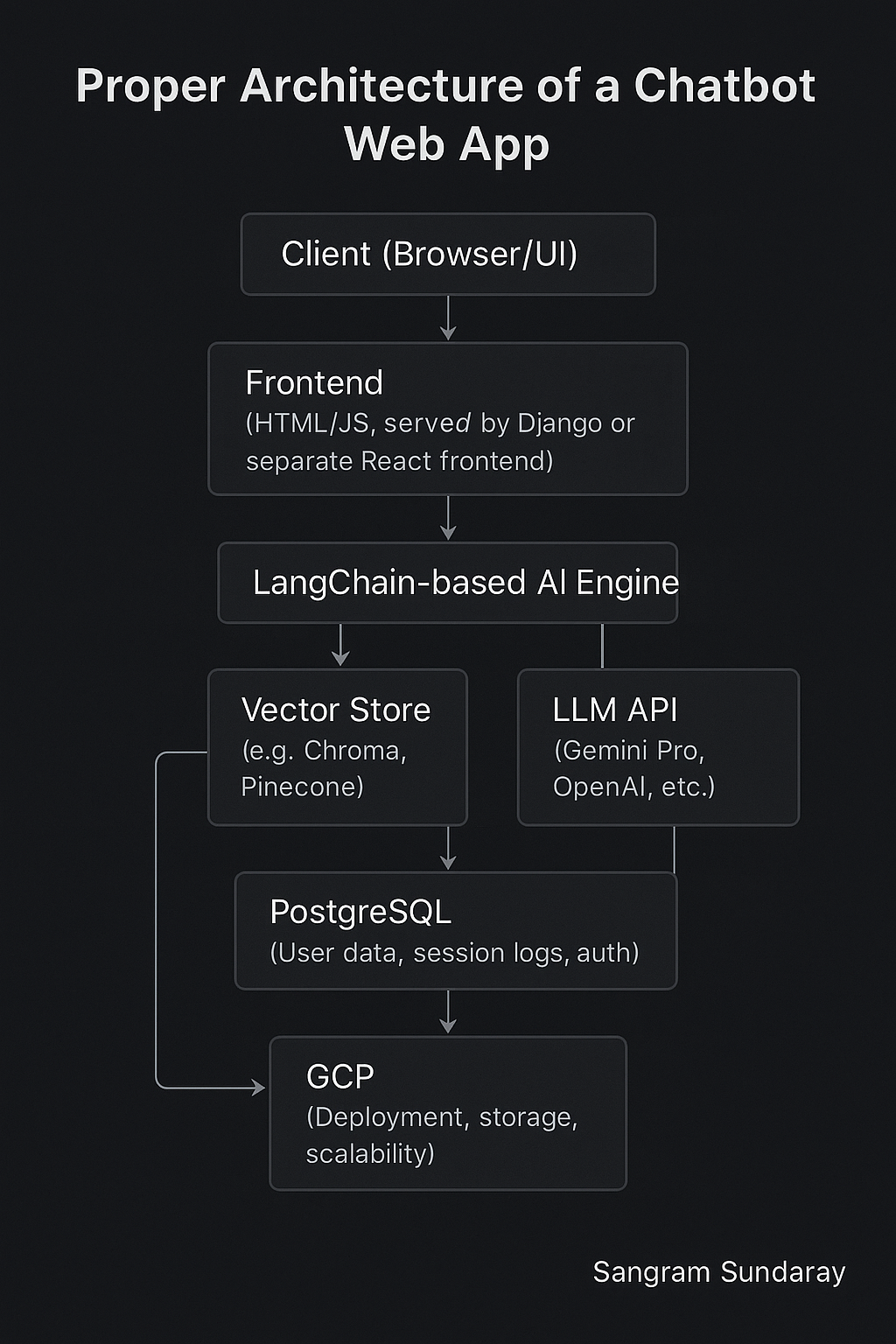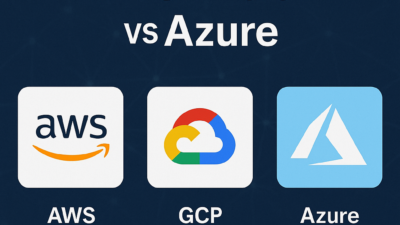Using Django, LangChain, PostgreSQL, Vector DB, and GCP
In this post, we’ll break down a modern chatbot web application architecture using:
✅ Django
✅ LangChain
✅ PostgreSQL
✅ Vector Database (like Pinecone or Chroma)
✅ Google Cloud Platform (GCP)
🧱 1. Architecture Overview
At a high level, here’s what the chatbot system looks like:

Client (Browser/UI)
|
Frontend (HTML/JS, served by Django or separate React frontend)
|
Django Backend (REST or WebSocket API)
|
LangChain-based AI Engine
├── Vector Store (e.g., Chroma, Pinecone)
└── LLM API (Gemini Pro, OpenAI, etc.)
|
PostgreSQL (User data, session logs, auth)
|
GCP (Deployment, storage, scalability)
🧠 2. LangChain-Powered Chat Engine
LangChain is the brain behind the scenes. It lets you:
- Orchestrate calls to LLMs (e.g., Gemini Pro, OpenAI)
- Perform context-aware querying with vector search
- Handle tools, memory, and agent flows
LangChain makes it easy to modularize your chatbot logic. For example:
from langchain.chains import RetrievalQA
from langchain.vectorstores import Chroma
from langchain.embeddings import GoogleGenerativeAIEmbeddings
from langchain.llms import ChatGoogleGenerativeAI
llm = ChatGoogleGenerativeAI(model="gemini-pro", temperature=0)
retriever = Chroma(persist_directory="vector_db").as_retriever()
qa_chain = RetrievalQA.from_chain_type(llm=llm, retriever=retriever)
🖥️ 3. Django – The Backend Framework
Django serves as the backbone of the application. It handles:
- User authentication (admin, customers, agents)
- API endpoints (
/chat,/history,/feedback) - Session management
- Admin UI to manage users, queries, logs, and documents
Structure your Django app into modules like:
core: common utilitieschat: chat session handlingapi: DRF-based endpoints for frontendvector_store: indexing and retrieval logic
💡 Tip: Use Django REST Framework (DRF) or Django Channels for WebSocket real-time chat.
🗃️ 4. PostgreSQL – For Structured Data
PostgreSQL is perfect for:
- User accounts and permissions
- Chat logs and history
- Feedback, ratings, intent tracking
- Admin audit logs
Tables to include:
users: authchat_sessions: session metadatachat_messages: logs per sessionvector_sources: indexed document metadata
🧠 5. Vector Database – Memory & Retrieval
AI chatbots need memory. That’s where vector databases come in.
Use Chroma (local) or Pinecone/Weaviate (cloud) to store vector embeddings of documents, FAQs, or previous chats.
- Embed text using Gemini or SentenceTransformers
- Store vectors with metadata (document type, tag, etc.)
- Retrieve semantically relevant chunks via similarity search
Vector store enables RAG (Retrieval-Augmented Generation) — a must-have for domain-specific bots.
☁️ 6. Google Cloud Platform – Deployment & Scale
Deploy your chatbot on GCP for reliability, security, and performance:
- Cloud Run: Scalable container deployment for Django + LangChain
- Cloud SQL: Managed PostgreSQL instance
- Cloud Storage: Store uploaded documents, logs, or audio
- Secret Manager: Manage LLM API keys and DB secrets
- VPC + IAM: Secure internal networking
Use Docker to package your app:
FROM python:3.11-slim
WORKDIR /app
COPY . .
RUN pip install -r requirements.txt
CMD ["gunicorn", "project.wsgi:application", "--bind", "0.0.0.0:8080"]
🧩 7. Putting It All Together
Your Django views or API endpoints will call LangChain chains, retrieve documents from the vector DB, and log everything to PostgreSQL.
Example flow:
- User query is posted to
/api/chat/ - Backend validates session/user
- LangChain engine:
- Embeds query
- Performs vector search
- Calls LLM with context
- Response is streamed back to frontend
- Logs are saved to DB
🎯 Conclusion
Building an AI chatbot requires thoughtful design. Using Django, LangChain, PostgreSQL, vector DBs, and GCP together creates a secure, scalable, and intelligent foundation.
Whether you’re building a personal assistant or an Islamic finance advisor, this architecture offers clarity, modularity, and production-grade readiness.
Ready to Build?
Spin up your Django app, integrate LangChain, connect to your vector DB, and deploy on GCP. You’re just a few steps away from launching an intelligent, scalable chatbot.

